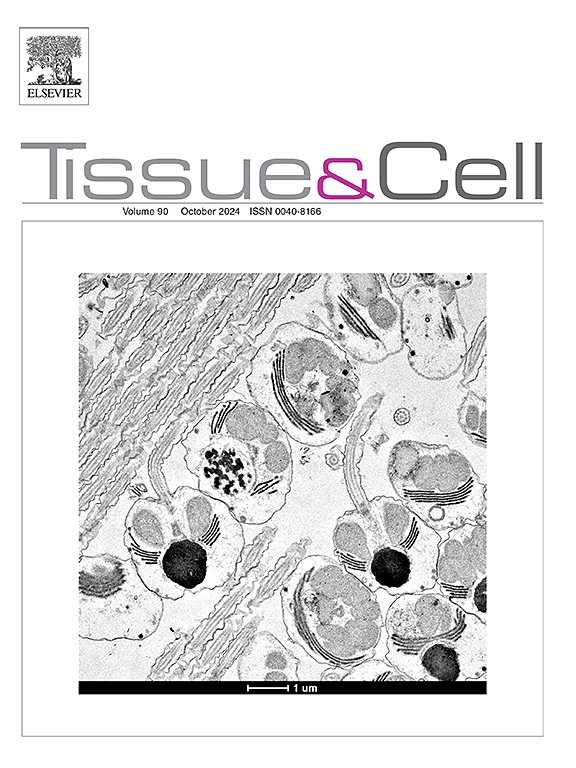花赛蛇的背腹侧皮肤(coluber flourulentus, perreti schatti, 1988):组织学、角蛋白免疫组化和超微结构表征
IF 2.5
4区 生物学
Q1 ANATOMY & MORPHOLOGY
引用次数: 0
摘要
本研究采用扫描电镜和组织学方法,对红花背侧和腹侧皮肤进行了表征,为其角蛋白免疫组化特征提供了新的认识。扫描电镜结果显示,两表面光滑鳞片重叠,鳞片形貌变化较小;背部鳞片呈指状,顶端呈尖状,而腹部鳞片扁平,边缘呈齿状。鳞片表面的顶端有两个大的球形透镜状感觉器官,外表面有穹丘形的感受器/感受器,穹丘形感受器上有树突、横裂和各种凹坑和孔。组织学上,两表面鳞片内表面的微纹饰结构相似,鳞片光滑,多刺,呈两层状。表皮层主要有基底层生发层、α-角蛋白层、中膜层、β层和被覆盖的奥伯豪臣层。两个表面的皮肤色素沉着不同:真皮背层含有黑色素细胞和虹膜细胞,而真皮腹层仅含有表皮层下的深黑色黑色素细胞。组织化学胶原纤维观察显示,背、腹表面真皮层有蓝色纤维,基底膜下稀疏,色素细胞和肌束周围可见。背侧和腹侧表皮细胞呈深棕色反应,腹侧表面细胞角蛋白免疫标记高,背侧表面细胞角蛋白免疫反应中等。总之,尺度对于控制运动和对物体运动的振动刺激做出反应至关重要,包括潜在猎物或捕食者的运动。本文章由计算机程序翻译,如有差异,请以英文原文为准。
Dorso-ventral skin of flowered racer snake (coluber flourulentus, perreti schatti, 1988): Histological, Keratin immunohistochemical, and ultrastructural characterization
Our study, using SEM and histology, aims to characterize the dorsal and ventral skin of Coluber flourulentus, providing new insights into their Keratin immunohistochemical features. The SEM findings revealed overlapping smooth scales on both surfaces, with minor scale morphology variations; the dorsal scales were finger-shaped with a pointed apex, while the ventral scales were flattened with tooth-like edges. Scales on both surfaces reveal two large, spherical-shaped lenticular sensory organs at their apex, dome-shaped receptors/sensilla on the outer surface, and dome-shaped sensilla with dendrites, a transverse cleft, and various pits and pores. Histologically, the micro-ornamentations on the inner-scale surfaces of both surfaces had similar structures with smooth, spiny scales and two layers. The epidermis layer had several layers, including the basal stratum germinativum, α-keratin, the Mesos layer, the β-layer, and the covered Oberhautchen layer. Skin pigmentation varied between both surfaces: the dorsal dermal layer contains melanophores and iridophores, and the ventral dermal layer contains only dark black melanophores under the epidermal layer. Histochemical collagen fiber observations revealed blue-colored fibers in the dermis of dorsal and ventral surfaces, sparse underneath the basement membrane, and visible around pigment cells and muscle bundles. A dark brown reaction was observed in the epidermal cells of both dorsal and ventral surfaces, with high cytokeratin immunolabeling on the ventral surface and moderate cytokeratin immunoreaction on the dorsal surface. In conclusion, scales were crucial for controlling movements and responding to vibrational stimuli from object movements, including those of potential prey or predators.
求助全文
通过发布文献求助,成功后即可免费获取论文全文。
去求助
来源期刊

Tissue & cell
医学-解剖学与形态学
CiteScore
3.90
自引率
0.00%
发文量
234
期刊介绍:
Tissue and Cell is devoted to original research on the organization of cells, subcellular and extracellular components at all levels, including the grouping and interrelations of cells in tissues and organs. The journal encourages submission of ultrastructural studies that provide novel insights into structure, function and physiology of cells and tissues, in health and disease. Bioengineering and stem cells studies focused on the description of morphological and/or histological data are also welcomed.
Studies investigating the effect of compounds and/or substances on structure of cells and tissues are generally outside the scope of this journal. For consideration, studies should contain a clear rationale on the use of (a) given substance(s), have a compelling morphological and structural focus and present novel incremental findings from previous literature.
 求助内容:
求助内容: 应助结果提醒方式:
应助结果提醒方式:


